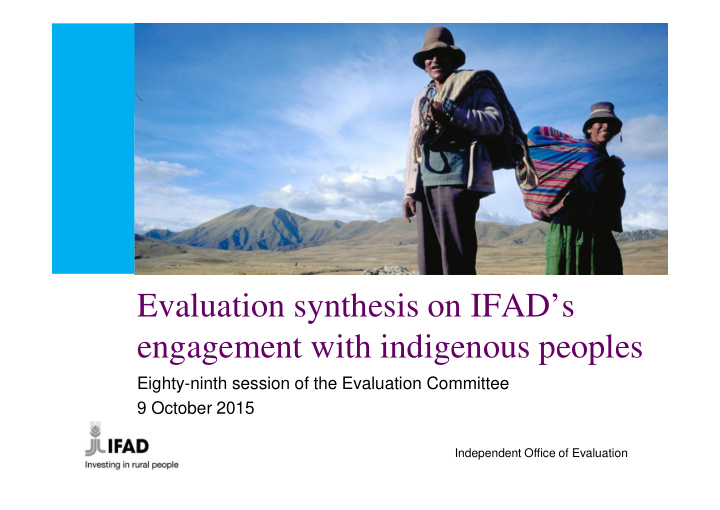



Evaluation synthesis on IFAD’s engagement with indigenous peoples Eighty-ninth session of the Evaluation Committee 9 October 2015 Independent Office of Evaluation
Key background information • 370 million indigenous peoples (IPs) worldwide according to the UN • IPs 5% of the world’s population, but 15% of the world’s poor • IFAD-financed investment projects 2004-2013 - Between 20 and 40% of projects approved in a year with IPs among expected beneficiaries - 14% of total investment over 10 years estimated to be in support of IPs (US$932 million) Independent Office of Evaluation
About this evaluation synthesis • Key guiding questions relating to: - Targeting and engaging with IPs - Participation of IPs in strategy development and projects - Empowerment of IPs - Contribution to policy engagement and advocacy on IPs issues • Main building blocks - Review of existing evaluations (8 CPEs, 19 project evaluations, mainly in LAC and APR, other evaluation products) - Review of COSOPs (old/new in 14 countries) and project designs to observe recent trends - Review of IFAD’s activities at global/regional levels Independent Office of Evaluation
Main findings • IFAD’s policy on indigenous peoples (2009): considered to be in line with international standards (UNDRIP) • The principles of engagement in the policy: in line with other IFAD corporate policies and strategies • Geographical targeting – common first step in most projects • Attention to IPs issues in COSOPs and recent project design: improvement observed but not consistent • Indigenous Peoples Assistance Facility (IPAF): a flagship programme but remained small and challenge with linkages with IFAD’s country programmes Independent Office of Evaluation
Main strengths • Long-standing and accumulated experience in engaging with IPs • Some investment projects: notable achievements in particular relating to empowerment, institutions and policies • IPAF partnerships and trust with IPs organization and their empowerment • Substantial contribution to international processes and advocacy • Indigenous Peoples’ Forum: a unique and pioneer mechanism to institutionalize dialogue with IPs • Inter-linkages between its operations and activities at different levels: at field level, international level, networks and partnerships Independent Office of Evaluation
Main areas for improvement • Insufficient attention to culture and identifies of IPs for tailored approach and strategy • Weakness in monitoring with disaggregated data and specific indicators • Lack of clarity on how to operationalize “free, prior and informed consent” (FPIC) = IPs participation throughout project cycle • Limited understanding of IPs’ issues among some staff Independent Office of Evaluation
Conclusions • Size and nature of projects and IFAD mandate enabled proactive approach to supporting IPs • IFAD is in a unique position to support indigenous peoples’ social and economic empowerment • IFAD perceived as a “partner” and “pioneer” in working with IPs • Building on experience and advantage, room for strengthening consistent IPs policy implementation, esp. at operational level Independent Office of Evaluation
Recommendations • Revisit the main objectives and strategies of IPAF • Pay greater attention to key project design elements and provide adequate implementation support • Provide guidance on how FPIC can be best operationalized • Enhance staff understanding of IPs’ issues • Strengthen knowledge management, taking advantage of substantial experience Independent Office of Evaluation
Recommend
More recommend